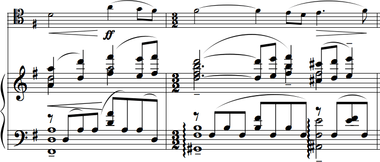Cello Sonata (Rachmaninoff)

Sergei Rachmaninoff's Cello Sonata in G minor, Op. 19, a sonata for cello and piano, was completed in November 1901[1] and published a year later.
Rachmaninoff disliked calling it a cello sonata because he thought the two instruments were equal.[2] Because of this, it is often referred to as Sonata in G minor for Cello and Piano. Most of the themes are introduced by the piano, while they are embellished and expanded in the cello's part.[3]
Premiere
He dedicated it to Anatoliy Brandukov, who gave the first performance in Moscow[4] with the composer at the piano, on 2 December 1901. Rachmaninoff seems to have made some last-minute alterations after the premiere, as he wrote the date "12 December 1901" on the score.[1] The sonata was overshadowed by the huge success of his Piano Concerto No. 2, which premiered on 27 October 1901.
Structure
As typical of sonatas in the Romantic period, it has four movements:
- Lento – Allegro moderato (G minor)
- Allegro scherzando (C minor)
- Andante (E-flat major)
- Allegro mosso (G major)
The work takes approximately 30 minutes to perform.[5]
Arrangements
- Arcadi Volodos transcribed the Andante of the work for piano solo and recorded it on Sony Classical.
References
- 1 2 Classical Archives
- ↑ Culshaw, J. (1949). Rachmaninoff. London: Dobson. p. 138.
- ↑ Harrison, Max (2006). Rachmaninoff: Life, Works, Recordings. London: Continuum. pp. 101–3. ISBN 0-8264-9312-2.
- ↑ Norris, Geoffrey (1993). The Master Musicians: Rachmaninoff. New York City: Schirmer Books. pp. 11, 19, 33, 38, 40, 123, 124, 168, 177. ISBN 0-02-870685-4.
- ↑ Hinson, Maurice; Wesley Roberts (2006). The Piano in Chamber Ensemble: An Annotated Guide. Bloomington, Indiana: Indiana University. p. 196. ISBN 0-253-34696-7.
External links
- Cello Sonata, Op. 19: Scores at the International Music Score Library Project